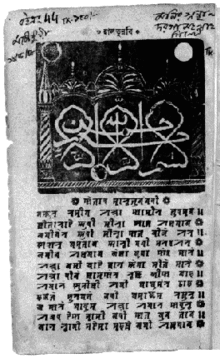Dobhashi
| Dobhashi Bengali | |
|---|---|
| দোভাষী | |
| Region | Bengal, Arakan |
| Era | 14th-19th century |
Indo-European
| |
| |
| Language codes | |
| ISO 639-3 | – |
Dobhashi (
Name
No name has been recorded for this register during its development and practice. In the 19th century, an
Structure
Dobhashi Bengali was highly influenced by Arabic and Persian and in poetry, could grammatically change to adapt to
The following is a sample text in Dobhashi Bengali of Article 1 of the Universal Declaration of Human Rights by the United Nations:
Dobhashi Bengali in the Bengali alphabet
- দফা ১: তামাম ইনসান আজ়াদ হয়ে সমান ইজ্জত আর হক লইয়া পয়দা হয়। তাঁহাদের হুঁশ ও আকল আছে; তাই একজন আরেক জনের সাথে বেরাদর হিসাবে সুলূক করা জ়রূরী।
Dobhashi Bengali in
- dôfa ek: tamam insan azad hôye shôman izzôt ar hôq lôiya pôyda hôy. tãhader hũsh o akôl achhe; tai ekjôn arek jôner shathe beradôr hishabe sulūk kôra zorūrī.
Gloss
- Point 1: All humans free manner-in equal dignity and right taken birth be. Their conscience and intelligence exist; thus one-person another person's with brother as behaviour do important.
English Translation
- Article 1: All human beings are born free and equal in dignity and rights. They possess conscience and reason. Therefore, everyone should act in a spirit of brotherhood towards each other.
History
| Part of a series on the |
| Bengal Sultanate |
|---|
 |
Influence on Bengali
The arrival of merchants, traders and missionaries from
The 14th-century Bengali Islamic scholar
Bharatchandra Ray, referred to the newly common language as "jabônī miśal", meaning Yāvanī-mixed. He says:[16]
মানসিংহ পাতশায় হইল যে বাণী, উচিত যে আরবী পারসী হিন্দুস্থানী;
পড়িয়াছি সেই মত বৰ্ণিবারে পারি, কিন্তু সে সকল লোকে বুঝিবারে ভারি,
না রবে প্রসাদ গুণ না হবে রসাল, অতএব কহি ভাষা যাবনী মিশাল।
mansingh patshay hôilô je baṇī, uchit je arôbī, parsī, hindustanī
poriyachhi shei môtô bôrṇibare pari, kintu she shôkôl loke bujhibare bhari
na rôbe prôshad guṇ na hôbe rôshal, ôtôeb kôhi bhasha jabônī mishal
This translates to: "The appropriate language for conversation between
Literary culture

Dobhashi literature is not considered to merely be the use of Persian loanwords in Bengali literature, but rather represents a phenomenon which developed much later, in the 17th century. Shah Faqir Gharibullah of
Medieval tales of Persian origin such as Gul-e-Bakavali were being translated to Dobhashi and being popularised in Bengal. Dobhashi puthis about the latter tale were written by the likes of Munshi Ebadat Ali in 1840. Muhammad Fasih was also a renowned Dobhashi puthi writer who was known to have written a 30-quatrain chautisa (poetic genre using all letters of the alphabet) using Arabic letters, totalling 120 lines.[24]
The famous Bangladeshi academic,
Decline
| Islam in Bangladesh |
|---|
 |
The
Nowadays, traditional Dobhashi is mostly used for research purposes though it is sometimes used to achieve particular literary effects. Remnants of the register are present in regional
See also
- Abdul Karim Sahitya Bisharad, historian who discovered hundreds of lost medieval literature and writers
- Bengali Kissa, popular genre found in Dobhashi literature
- Bengali poetry
- Puthi, popular genre found in Dobhashi literature
- Yusuf-Zulekha, an early Dobhashi work
References
- OL 30677644M. Retrieved 21 April 2024.)
{{cite encyclopedia}}: CS1 maint: multiple names: authors list (link - ^ Thibaut d'Hubert, Alexandre Papas (2018). Jāmī in Regional Contexts: The Reception of ʿAbd al-Raḥmān Jāmī’s Works in the Islamicate World, ca. 9th/15th-14th/20th Century. pp.678. BRILL. Retrieved on 9 September 2020.
- ^ a b Dil, Afia (2012). "Impact of Arabic on Bengali Language and Culture". Journal of the Asiatic Society of Bangladesh: 101–152.
- ^ Mandal, Mousumi (17 March 2017). "Bonbibi-r Palagaan: Tradition, History and Performance". Sahapedia.
- ^ Abdul Mannan, Kazi (1966). The Emergence and Development of Dobhasi Literature in Bengal (up to 1855 AD) (Thesis). University of Dhaka.
- OL 30677644M. Retrieved 21 April 2024.
- ^ ISBN 9780190860356.
- ^ Bangladesh Itihas Samiti (1999). Sylhet: History and Heritage. pp.598.
- ^ J. K. Mandal, Goutam Saha, Debatta Kandar, Arnab Kumar Maji (2018). Proceedings of the International Conference on Computing and Communication System: 13CS 2016, NEHU, Shillong, India. pp.452. Springer. Retrieved on 9 September 2020.
- ^ Ekmeleddin İhsanoğlu (2003). Culture and Learning in Islam. pp.115. UNESCO. Retrieved on 9 September 2020.
- ISBN 978-0-520-20507-9.
- ^ Rabbani, AKM Golam (7 November 2017). "Politics and Literary Activities in the Bengali Language during the Independent Sultanate of Bengal". Dhaka University Journal of Linguistics. 1 (1): 151–166. Archived from the original on 11 October 2017. Retrieved 7 November 2017 – via www.banglajol.info.
- ^ "The development of Bengali literature during Muslim rule" (PDF). Blogs.edgehill.ac.uk. Archived from the original (PDF) on 9 August 2017. Retrieved 7 November 2016.
- Dacca: Mawla Brothers. p. 99.
- OL 30677644M. Retrieved 21 April 2024.
- ^ Bankim Chandra Chatterjee (1888). Bangadarshan (in Bengali). Vol. 2. p. 39.
- ISBN 0-19-566542-2.
- ^ Dil, Afia (1972). The Hindu and Muslim Dialects of Bengali. Committee on Linguistics, Stanford University. p. 54.
- ^ Chatterjee, Nandini (3 April 2018). "On scripting Bengali". Lawforms.
- ^ Khan Sahib, Maulavi Abdul Wali (2 November 1925). A Bengali Book written in Persian Script.
- ^ Ahmad, Qeyamuddin (20 March 2020). The Wahhabi Movement in India. Routledge.
- ^ Ahmad Hasan Dani (1958). শ্রীহট্ট-নাগরী লিপির উৎপত্তি ও বিকাশ. Bangla Academy (in Bengali): 1.
- OL 30677644M. Retrieved 21 April 2024.
- OL 30677644M. Retrieved 21 April 2024.
- OL 30677644M. Retrieved 21 April 2024.
- ^ Uddin, Sufia M (2006). "Nineteenth-Century Religious Reform Movements". Constructing Bangladesh: Religion, Ethnicity, and Language in an Islamic Nation. University of North Carolina. p. 70.
- ^ Sen, Sandipan (2014). "Sanskritisation of Bengali, Plight of the Margin and the Forgotten Role of Tagore" (PDF). Journal of the Department of English. 11. Vidyasagar University.
- Calcutta: Ratna Prakashan.
- )

